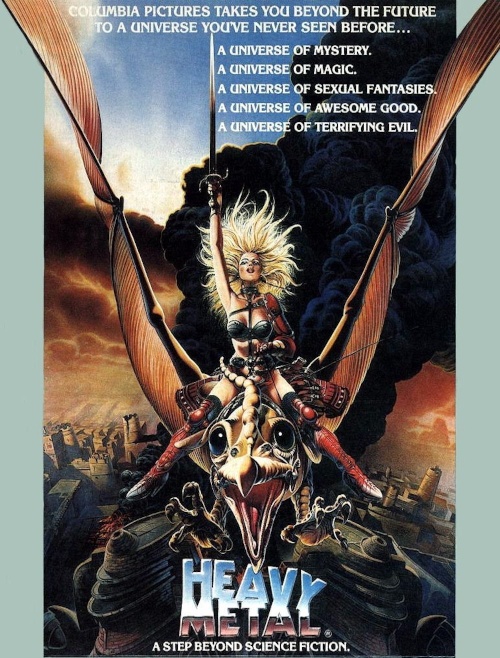Monday, July 26, 2021
Heavy Metal (1981)
The Heavy Metal/Métal hurlant franchise is awesome, if you are familiar with the material then you probably love it. That is a testament to the fantastic work of French comic artists and the animators who made this first American film. The anthology format of this and subsequent adaptations lends itself well to stories of raw passion and violence.
What is perhaps most interesting about Heavy Metal is that it crosses time and space to tell stories of human triumph over enemies, society, and life in general. It does not falter in its unflinching awareness of how the universe really is. It doesn’t lie as much as the Disney shit.

Here is a detailed franchise timeline if you care:
1974 - Métal hurlant - A groundbreaking comics magazine takes France by storm
1977 - Heavy Metal - The magazine is translated to English for an American audience
1981 - Heavy Metal - This film
1990 - Ranx: The Video Game - A (probably crap) game based on the comics
1996 - Heavy Metal gets a proper theatrical re-release and home video release
2000 - Heavy Metal 2000 - The sequel departs from the anthology form but isn’t bad
2000 - Heavy Metal: F.A.K.K. 2 - Third-person action game pseudo-sequel, not bad but not great
2008 - Paramount shoots down another sequel
2012-2014 - Métal Hurlant Chronicles - French live-action TV show. It’s awesome.
2019-present - Love, Death & Robots - Animated Netflix series that does not actually license the brand
The long gaps in the 1980s and 2000s directly follow big movie releases, which tells me there is only one pool of money for this franchise, and the spigot is not kept open like it is for Fast and Furious. To paraphrase Paramount, “too risque for mainstream audiences”. (mainstream=American)
Let’s go back to the 1980s mindset. To release a film simply titled “Heavy Metal” to a fresh audience is bold. The comics, which had involvement from the likes of Alejandro Jodorowsky and H.R. Giger, may not be as bold as the underground stuff or as precise as manga, but in America, adult illustration has never been prominent. Before anyone knew what it was, it hit the big screen.
Imagine walking into a theater and seeing a convertible drop from orbit, burn through the atmosphere, parachute down. The astronaut kicks it into gear, cuts through a cornfield, and stops at a house. He walks in and you see his face, just some guy. His daughter asks “what did you bring me?” and he just says “you’ll see”. Oh yeah baby, you will.
The framing device is a glowing green thing called the Locnar. In its 1950s horror movie voice it claims to be the son of four evils, etc. It’s a badass space thing that infects every galaxy, every dimension, or whatever. It represents what you could call the metal in all of us, just like the “screaming metal” asteroid face in that Métal Hurlant Chronicles show.
The Locnar first shows us two 15-minute segments:
* The plight of a redhead and a cab driver caricature. This one is pretty good.
* A fantasy that riffs on Conan. A teenage science enthusiast gets sucked into another dimension and has to fight stuff.
Followed by three under-10-minute segments:
* A big-chinned space captain, who is of course a total asshole, runs from a giant he pissed off.
* A downed airman runs from zombies in World War II. Could have used more fighting.
* The US government is involved with aliens, and everybody lets loose like nobody’s business. I love this one, as it’s essentially the cab driver story but in space. Too bad it’s so short.
We enter the third act and the centerpiece is displayed:
A warrior race in a post-industrial neolithic age attack a peaceful people who worship the heavy metal deity Karna. This lore is derived from the long-understood notion of barbarians from the Eurasian far north, exotic encounters between geographically distant breeds that left strong impressions on classical writers, and of course the modern interpretations such as Conan the Barbarian. This time it’s cyborg zombies, who fight the character pictured on the poster, a warrior goddess that rides a giant bird.
This is American animation that doesn’t suck, and the franchise’s popularity endures. With no shortage of content, most of it of a very high quality, this film is your gateway to the closest thing the western world has to anime.